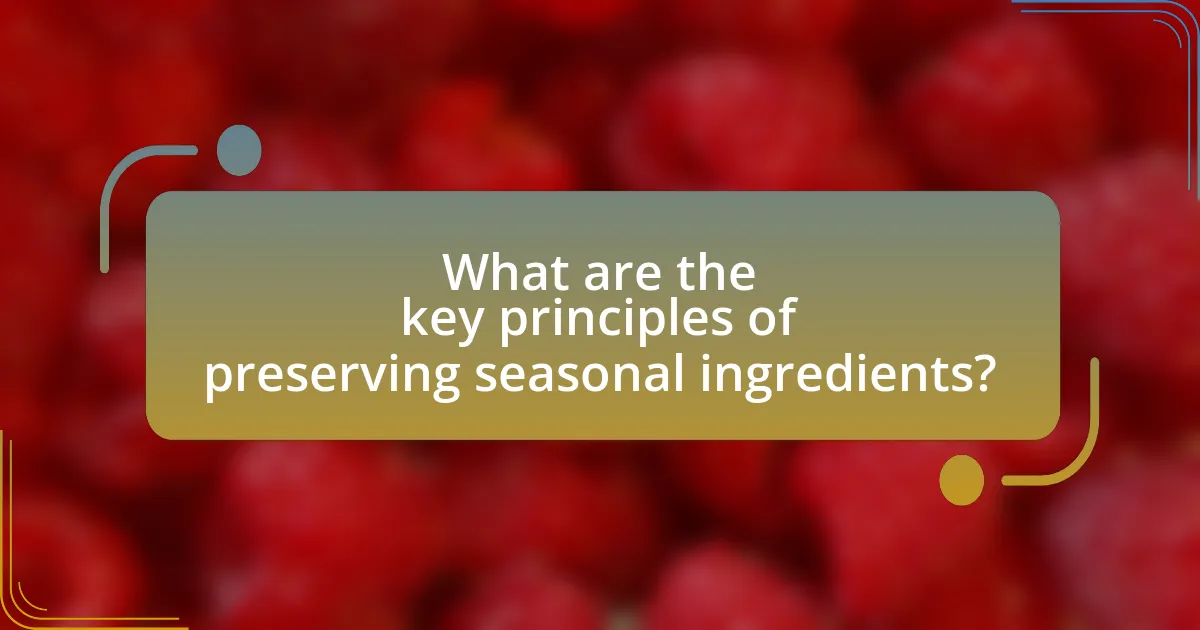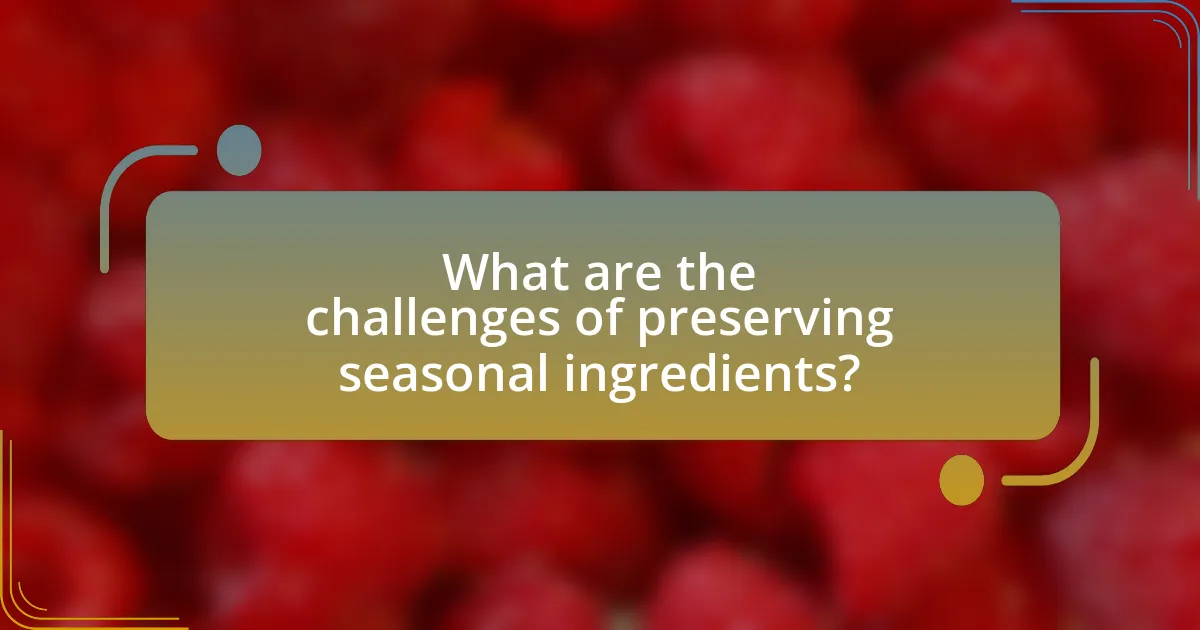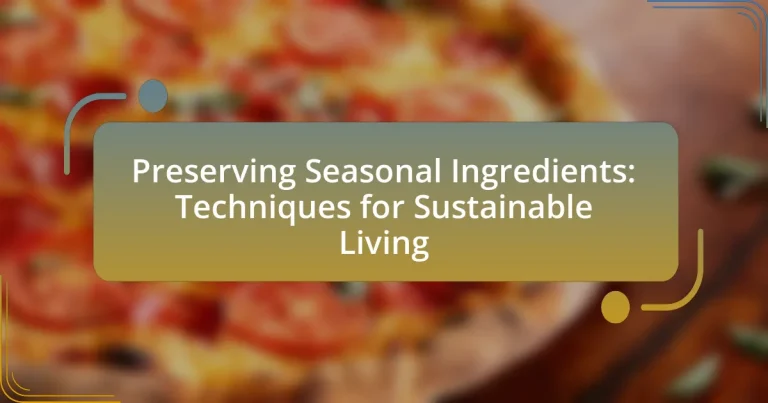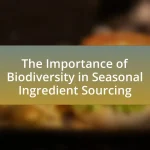The article focuses on the preservation of seasonal ingredients as a means to promote sustainable living. It outlines key principles such as proper selection, preservation methods, and maintaining quality, emphasizing techniques like canning, freezing, drying, and fermenting. The environmental benefits of preserving seasonal produce are highlighted, including reduced food waste and lower carbon footprints. Additionally, the article discusses how these practices support local economies and provides practical tips for selecting and utilizing seasonal ingredients effectively in meal planning and cooking. Overall, it serves as a comprehensive guide to the importance and methods of preserving seasonal ingredients for sustainability.

What are the key principles of preserving seasonal ingredients?
The key principles of preserving seasonal ingredients include proper selection, appropriate preservation methods, and maintaining quality throughout the process. Selecting fresh, ripe ingredients at their peak ensures maximum flavor and nutritional value. Common preservation methods such as canning, freezing, drying, and fermenting help extend the shelf life of these ingredients while retaining their essential qualities. For instance, canning involves heating jars to kill bacteria, which allows for long-term storage without refrigeration. Additionally, maintaining quality involves using clean equipment, monitoring storage conditions, and labeling preserved items with dates to ensure they are consumed while still safe and flavorful. These principles are essential for effective preservation and contribute to sustainable living by reducing food waste.
How does preserving seasonal ingredients contribute to sustainable living?
Preserving seasonal ingredients contributes to sustainable living by reducing food waste and minimizing the carbon footprint associated with food transportation. When seasonal ingredients are preserved, such as through canning or drying, they can be stored for longer periods, allowing consumers to utilize them throughout the year. This practice decreases reliance on out-of-season produce, which often requires long-distance shipping, thus lowering greenhouse gas emissions. Additionally, according to the Food and Agriculture Organization, approximately one-third of food produced globally is wasted, and preserving seasonal ingredients directly addresses this issue by extending the shelf life of food and promoting efficient consumption.
What are the environmental benefits of preserving seasonal ingredients?
Preserving seasonal ingredients offers significant environmental benefits, primarily by reducing food waste and minimizing carbon footprints. When seasonal produce is preserved, it extends the shelf life of food, thereby decreasing the amount of edible food that is discarded. According to the Food and Agriculture Organization, approximately one-third of all food produced globally is wasted, contributing to greenhouse gas emissions. Additionally, using seasonal ingredients reduces the need for energy-intensive transportation and storage, as these foods are often grown locally and harvested at their peak. This practice supports local agriculture, which can lead to more sustainable farming practices and biodiversity conservation.
How does preserving seasonal ingredients support local economies?
Preserving seasonal ingredients supports local economies by enhancing the market for local farmers and producers. When consumers prioritize seasonal foods, they create a demand that encourages local agricultural practices, which in turn stimulates job creation within the community. According to a study by the USDA, local food systems can generate up to four times the economic impact compared to conventional food systems, as money spent on local products tends to circulate within the community. This economic activity fosters resilience and sustainability in local economies, ensuring that farmers receive fair compensation and that consumers have access to fresh, nutritious food.
What methods can be used for preserving seasonal ingredients?
Methods for preserving seasonal ingredients include canning, freezing, drying, and fermenting. Canning involves sealing ingredients in jars and heating them to kill bacteria, which allows for long-term storage. Freezing preserves the freshness of ingredients by lowering the temperature to inhibit microbial growth. Drying removes moisture from ingredients, preventing spoilage and extending shelf life. Fermenting utilizes beneficial bacteria to transform ingredients, enhancing flavor and preservation. Each method effectively extends the usability of seasonal produce, ensuring food security and reducing waste.
What are the most common techniques for preserving fruits and vegetables?
The most common techniques for preserving fruits and vegetables include canning, freezing, drying, and pickling. Canning involves sealing food in jars and heating them to kill bacteria, which allows for long-term storage; this method dates back to the early 19th century and is widely used for various fruits and vegetables. Freezing preserves the texture and nutritional value by slowing down enzyme activity, making it a popular choice for seasonal produce. Drying removes moisture, inhibiting the growth of microorganisms, and has been utilized for centuries, particularly in arid climates. Pickling involves immersing food in vinegar or brine, which creates an acidic environment that prevents spoilage; this technique has historical roots in many cultures around the world. Each of these methods effectively extends the shelf life of fruits and vegetables while maintaining their flavor and nutritional content.
How do fermentation and pickling differ in preserving ingredients?
Fermentation and pickling are distinct methods of preserving ingredients, primarily differing in their processes and the role of microorganisms. Fermentation involves the conversion of sugars into acids, gases, or alcohol by microorganisms such as bacteria or yeast, resulting in products like yogurt or sauerkraut. In contrast, pickling typically involves immersing ingredients in a solution of vinegar or brine, which acts as a preservative without the need for microbial activity.
The fermentation process not only preserves food but also enhances its nutritional profile and flavor through the production of beneficial probiotics. For example, fermented foods can contain live cultures that promote gut health. On the other hand, pickling primarily relies on the acidity of vinegar or salt to inhibit spoilage, making it a quicker method for preservation without the complex biochemical changes seen in fermentation.
Both methods effectively extend the shelf life of ingredients, but fermentation offers additional health benefits through microbial action, while pickling provides a straightforward preservation technique using acidic solutions.

What are the best practices for selecting seasonal ingredients?
The best practices for selecting seasonal ingredients include understanding local growing seasons, prioritizing freshness, and choosing organic options when possible. Local growing seasons vary by region, so researching what fruits and vegetables are in season in your area ensures optimal flavor and nutritional value. Freshness is crucial, as seasonal ingredients are typically harvested at their peak, leading to better taste and higher nutrient content. Additionally, selecting organic seasonal ingredients can reduce exposure to pesticides and support sustainable farming practices, which is beneficial for both health and the environment. Studies show that seasonal produce often contains more vitamins and minerals compared to out-of-season options, reinforcing the importance of these practices.
How can consumers identify seasonal ingredients in their region?
Consumers can identify seasonal ingredients in their region by consulting local farmers’ markets, seasonal produce guides, and agricultural extension services. Farmers’ markets typically showcase fruits and vegetables that are currently in season, providing a direct source of information. Seasonal produce guides, often available online or through local agricultural organizations, list items that are at their peak during specific months. Additionally, agricultural extension services offer resources and expertise on local growing seasons, helping consumers understand what ingredients are available throughout the year. This approach is supported by the fact that seasonal eating promotes sustainability and supports local economies, as highlighted by studies from the USDA and various agricultural research institutions.
What resources are available for finding seasonal produce guides?
Seasonal produce guides can be found through various resources, including agricultural extension services, local farmers’ markets, and online databases. Agricultural extension services, often affiliated with universities, provide region-specific information on what fruits and vegetables are in season. Local farmers’ markets typically offer seasonal produce lists that reflect the availability of local crops. Additionally, websites like Seasonal Food Guide and Eat Seasonably provide comprehensive online databases that detail seasonal produce by region and month, helping consumers make informed choices about fresh ingredients.
How does understanding seasonality enhance culinary experiences?
Understanding seasonality enhances culinary experiences by allowing chefs and home cooks to utilize the freshest ingredients, which improves flavor and nutritional value. Seasonal ingredients are often harvested at their peak ripeness, resulting in superior taste and texture compared to out-of-season produce, which may be stored for long periods or transported over great distances. For example, tomatoes in summer are sweeter and juicier than those available in winter. Additionally, using seasonal ingredients supports local agriculture and reduces carbon footprints associated with transportation, aligning with sustainable living practices. This connection to local food systems fosters a deeper appreciation for the culinary arts and encourages creativity in meal preparation.
What factors should be considered when purchasing seasonal ingredients?
When purchasing seasonal ingredients, factors such as freshness, availability, price, and environmental impact should be considered. Freshness is crucial as seasonal ingredients are typically harvested at their peak, ensuring optimal flavor and nutritional value. Availability varies by region and season, influencing the selection of ingredients. Price often reflects the supply and demand dynamics of seasonal produce, making it more economical to purchase in-season items. Additionally, considering the environmental impact, such as carbon footprint and sustainability practices of local farms, supports eco-friendly choices. Research indicates that consuming seasonal produce can reduce transportation emissions and promote local economies, reinforcing the importance of these factors in purchasing decisions.
How do freshness and quality impact the preservation process?
Freshness and quality significantly influence the preservation process by determining the effectiveness and longevity of preserved items. Fresh ingredients contain higher levels of nutrients and fewer microorganisms, which enhances their ability to withstand preservation methods such as canning, freezing, or drying. For instance, studies show that fruits and vegetables preserved within hours of harvest retain more vitamins and minerals compared to those stored for extended periods before processing. Additionally, high-quality ingredients often exhibit better flavor and texture post-preservation, making them more desirable for consumption. Therefore, prioritizing freshness and quality directly correlates with successful preservation outcomes.
What role do local farmers’ markets play in sourcing seasonal ingredients?
Local farmers’ markets play a crucial role in sourcing seasonal ingredients by providing direct access to fresh produce that is harvested at its peak ripeness. These markets facilitate the connection between local farmers and consumers, ensuring that seasonal ingredients are available and promoting the consumption of foods that are in season. Research indicates that purchasing from farmers’ markets can lead to a 30% increase in the consumption of fruits and vegetables, as these markets often feature a diverse array of seasonal offerings. Additionally, farmers’ markets support local economies and reduce the carbon footprint associated with transporting food over long distances, further enhancing the sustainability of sourcing seasonal ingredients.

What are the challenges of preserving seasonal ingredients?
The challenges of preserving seasonal ingredients include maintaining flavor and nutritional quality, managing spoilage, and ensuring proper storage conditions. Seasonal ingredients often have a limited shelf life, which can lead to rapid deterioration if not preserved correctly. For instance, fruits and vegetables may lose their taste and nutrients during freezing or canning processes, as studies show that certain vitamins degrade over time when exposed to heat or air. Additionally, improper storage can result in mold growth or spoilage, making it essential to control humidity and temperature. These factors complicate the preservation process, requiring careful planning and execution to ensure that the ingredients retain their desired qualities.
What common mistakes should be avoided when preserving ingredients?
Common mistakes to avoid when preserving ingredients include inadequate sterilization of jars, improper temperature control, and using unsuitable ingredients. Inadequate sterilization can lead to bacterial contamination, compromising food safety. For example, the USDA recommends boiling jars for at least 10 minutes to ensure they are properly sanitized. Improper temperature control during the preservation process can result in spoilage; maintaining the correct temperature is crucial for methods like canning and freezing. Additionally, using unsuitable ingredients, such as overripe fruits or vegetables, can affect the quality and longevity of preserved items. Following these guidelines helps ensure successful preservation and enhances food safety.
How can improper preservation techniques affect food safety?
Improper preservation techniques can significantly compromise food safety by allowing the growth of harmful bacteria, molds, and toxins. For instance, inadequate refrigeration can lead to the proliferation of pathogens such as Salmonella and E. coli, which thrive in temperatures above 40°F. Additionally, improper canning methods can result in botulism, a severe foodborne illness caused by the toxin produced by Clostridium botulinum, which can survive in improperly sealed jars. According to the Centers for Disease Control and Prevention (CDC), foodborne illnesses affect millions of people annually, highlighting the critical importance of proper preservation methods to ensure food safety.
What are the signs of spoilage in preserved ingredients?
Signs of spoilage in preserved ingredients include off odors, discoloration, mold growth, and changes in texture. Off odors indicate microbial activity, while discoloration often suggests chemical changes or oxidation. Mold growth, visible as fuzzy patches, signifies contamination, and changes in texture, such as excessive softness or dryness, can indicate degradation. These signs are critical for ensuring food safety and maintaining quality in preserved ingredients.
How can individuals overcome challenges in preserving seasonal ingredients?
Individuals can overcome challenges in preserving seasonal ingredients by utilizing methods such as canning, freezing, and fermenting. Canning allows for long-term storage of fruits and vegetables by sealing them in jars, which can last for years when done correctly. Freezing preserves the freshness and nutritional value of seasonal produce, as it halts the enzymatic processes that lead to spoilage. Fermenting not only extends the shelf life of ingredients but also enhances their flavor and nutritional profile through the development of beneficial probiotics. These techniques are supported by the USDA guidelines, which provide detailed instructions on safe preservation practices, ensuring that individuals can effectively store seasonal ingredients while maintaining food safety.
What resources are available for learning effective preservation techniques?
Books, online courses, and workshops are valuable resources for learning effective preservation techniques. Notable books include “The Complete Book of Home Preserving” by Judi Kingry and Lauren Devine, which provides comprehensive methods for canning, freezing, and drying foods. Online platforms like Coursera and Udemy offer courses on food preservation, often taught by experts in the field. Additionally, local agricultural extension offices frequently conduct workshops and provide materials on preservation methods tailored to regional ingredients. These resources collectively equip individuals with practical skills and knowledge for sustainable food preservation.
How can community support enhance the preservation of seasonal ingredients?
Community support can enhance the preservation of seasonal ingredients by fostering local agricultural practices and encouraging sustainable consumption. When communities prioritize local farms and seasonal produce, they create a demand that incentivizes farmers to grow and maintain diverse crops, which helps preserve traditional farming methods. For instance, community-supported agriculture (CSA) programs have been shown to increase the viability of small farms, as they provide upfront financial support and a guaranteed market for seasonal produce. This model not only sustains local economies but also promotes biodiversity and reduces reliance on imported goods, thereby preserving the integrity of seasonal ingredients.
What practical tips can enhance the preservation of seasonal ingredients?
To enhance the preservation of seasonal ingredients, utilize methods such as freezing, canning, and drying. Freezing locks in nutrients and flavor, making it ideal for fruits and vegetables; for instance, blanching vegetables before freezing can preserve their color and texture. Canning allows for long-term storage of ingredients like tomatoes and pickles, with proper sterilization preventing spoilage. Drying removes moisture, which inhibits bacterial growth, and is effective for herbs and fruits; studies show that dried herbs retain their flavor and potency for months. These techniques not only extend the shelf life of seasonal produce but also contribute to reducing food waste, aligning with sustainable living practices.
How can meal planning incorporate preserved seasonal ingredients effectively?
Meal planning can effectively incorporate preserved seasonal ingredients by utilizing them as key components in recipes, ensuring that their flavors and nutritional benefits are maximized. For instance, preserved tomatoes can be used in sauces, soups, or stews, while pickled vegetables can enhance salads and sandwiches. This approach not only reduces food waste but also allows for a diverse range of meals throughout the year, as preserved ingredients maintain their quality and taste. Studies show that incorporating preserved foods can lead to a more sustainable diet, as they often require less energy for storage and transportation compared to fresh produce out of season.
What are some creative ways to use preserved ingredients in everyday cooking?
Preserved ingredients can be creatively used in everyday cooking by incorporating them into various dishes to enhance flavor and nutrition. For example, pickled vegetables can be added to salads or sandwiches for a tangy crunch, while preserved fruits can be blended into smoothies or used as toppings for yogurt and desserts. Additionally, dried herbs and spices can elevate the taste of soups, stews, and marinades, providing depth and complexity.
Using preserved ingredients not only reduces food waste but also allows for year-round access to seasonal flavors. Studies show that incorporating preserved foods can contribute to a balanced diet, as they often retain essential nutrients. For instance, tomatoes preserved through canning maintain high levels of lycopene, a beneficial antioxidant.


